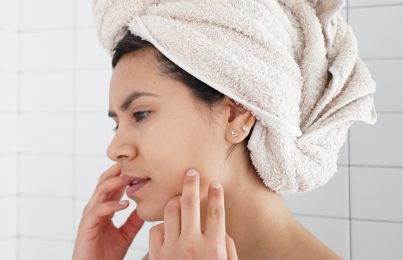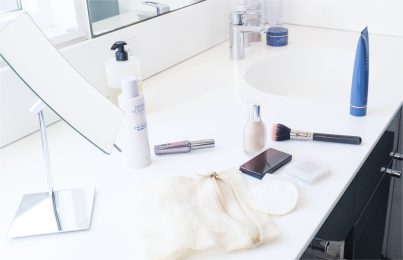Updated 01/18/22. Let’s cut right to the chase. Winter can be incredibly harsh on the skin. With freezing temperatures, dry air, and gusty winds, it’s no wonder why people experience things like chapped lips and cracked heels, and it can be hard to know where to start when you’re trying to get your skin back on track. That’s where I come in. Here are my expert solutions to eight common winter skin issues.
1. Chapped Lips
This is one of the most common winter skin issues out there. There’s nothing worse than going to apply a beautiful lipstick or gloss, only to realize that it’s accentuating dry, chapped lips. What’s worse is that dry lips can be pretty painful!
Our lips are different from the rest of our skin because they don’t produce oil. Combine this with the fact that they experience a lot of wear and tear (talking, eating, kissing, drinking, etc.) and it can be a real challenge to keep them hydrated in the cold, dry air.
The Solution
- Look For a Lip Balm With Occlusive Ingredients. Occlusive ingredients help create a protective seal over the skin to keep moisture locked in. These include ingredients like shea butter and dimethicone.
- Exfoliate With a Gentle Lip Scrub. This will remove dead, flaky skin that’s built up on your lips so your lip balm can be more effective. If you don’t have a lip scrub, you can use a soft, damp washcloth instead. Just wipe it gently over the lips to remove superficial dryness.
- Protect Your lips With SPF. This is so important! A lot of people overlook this, but sun exposure can cause irritation and dryness. It’s best to wear a lip product with SPF 20 or higher every day.
- Sleep With a Humidifier In Your Room. This can help address the root cause of chapped lips and “recharge” your moisture levels so you’re ready for the day ahead!
- Avoid Peeling Dry, Flaky Skin. It’s tempting to pull and peel dry, flaky skin, but doing so can cause the lips to bleed if you accidentally remove skin that’s still attached to live cells. Ouch!
Keep in mind, it’s not just about how you deal with chapped lips. It’s also about what you do to prevent them in the first place. Learn how to prevent chapped lips in the winter!
2. Cracked Heels
Cracked heels seem to get worse and worse as winter drags on. This can be a real annoyance once it’s time to wear sandals again. The feet don’t naturally retain much moisture, so once the air gets cold and dry, cracked heels are almost inevitable. Staying on top of it and preventing the cracking in the first place is easier than trying to correct the dryness and damage once it appears.
The Solution
So, what can you do? Every night, I slather a thick ointment or salve on my feet (my go-to is Beside Body Balm). Then, I put on a pair of cotton socks to wear overnight. This prevents moisture from escaping and really helps force the ointment to soak into my feet. I also suggest wearing socks during the day as much as possible since this will prevent moisture loss to some degree. Learn more about how to prevent dry, cracked heels in the first place!
3. Dry, Flaky Skin on the Face
This has to be one of the most common skin complaints I hear from clients and customers throughout winter. It’s not always easy to identify what’s causing dry, flaky skin on the face, but the fact is, a damaged moisture barrier almost always comes into play.
It can be really challenging to keep your skin’s natural moisture barrier intact during this unforgiving season. Cold temperatures and low humidity cause the dry air to pull water out of your skin (dry air is greedy and will steal moisture from anywhere it can get it). This damages your barrier and causes tiny, invisible cracks in the skin. Moisture escapes through these cracks making it even harder for your skin to retain it. It’s truly a vicious cycle!
The Solution
The best solution to this winter skin issue is two-fold. First, you want to apply skincare products that keep moisture in. I suggest using Skin Recovery Balm. This moisturizer was specifically formulated to correct dryness by creating a moisture locking seal when applied. Second, you want to exfoliate regularly. Exfoliating the skin will lift away dry, expired cells so hydrating products can get straight to work. Just be sure to use the right exfoliant for your skin type and follow it up with a moisturizer. (Finally, make sure you know the difference between dry and dehydrated skin, because, no, they’re not the same thing!)
4. Dry, Peeling Nose
Sometimes, I find that even when people get the dry, flaky skin on their face under control, they can’t seem to stop their nose from peeling. This usually happens on the top, sides, or corners of the nose. There can be a number of reasons for this, including:
- Environmental Exposure. Winter air is often exceptionally cold and dry. It can dry out the mucus membrane of the nose, making it hard for the surrounding skin to retain moisture.
- UV Damage. Since our noses protrude off our faces, they’re especially prone to sun exposure. Over time, this can thicken the skin and dry it out, causing a peeling or flaking effect. Keep in mind that if this peeling persists over time (especially after you’ve been doing your best to address it), it could be an early sign of skin cancer. In this case, it’s always best to get it checked by a dermatologist.
- Allergies or Sickness. Ah yes, cold and flu season! There’s nothing more miserable than a stuffy, runny nose. If you’re constantly blowing your nose, it can essentially cause it to become chapped. (On that note, make sure you know how to care for your skin when you have a cold.)
- Skin Conditions. If you deal with skin conditions such as eczema or rosacea, winter climates may exacerbate flakiness.
- Skincare Products. Finally, your skincare routine could be causing dryness and peeling on your nose. I see people make two common mistakes. The first is overdoing it with exfoliation. The second is using products that are too drying (especially breakout-focused products). The reality is, as the seasons change, so should your skincare routine. (Here are the best skincare products to use in winter.)
The Solution
I have an entire blog post on how to solve this winter skin issue! Make sure you check it out.
One easy solution may be to use a thicker cream on your nose than you would use on the rest of your face. This is to promote a stronger barrier against the cold, dry air. For this, I suggest using the Skin Recovery Balm.
5. Dull, Tired-Looking Skin
As far as I’m concerned, there are four things that truly give the skin a “glow:”
- Small pores and smooth texture
- Good circulation
- Even skin tone
- Moisture
Glowing skin is ultimately skin that is light-reflective. Since light doesn’t bounce off of dry and dehydrated skin cells, it has the tendency to look dull and tired.
The Solution
Boosting your skin’s moisture levels is the key to getting a “glow.” You definitely want to focus on maintaining a strong moisture barrier throughout the winter. Looking for a little extra oomph? Here are another 10 ways to give your skin a glow.
6. Dry Skin on the Body
It’s not just our faces that suffer from dryness during winter! It’s the skin on the body, too. While it’s easy to neglect the skin on the body, you’ll want to step it up once the temperatures drop. The main problems you want to avoid are itchy and/or bumpy skin since this can be uncomfortable, but beyond that, this can cause damage from excessive scratching.
The Solution
For starters, you’ll want to remove any dry, dead skin cells a few times a week by gently scrubbing them off. This can be done in the shower using a loofah or dry brush, or you can prep for your shower by using the Back and Body Buffing Towel for hard to reach places. If you’re prone to bumps and need a little extra help, you may want to reach for a body product with exfoliating acids, like the DERMAdoctor KP Duty Peel Pads or DERMAdoctor KP Duty Lotion. Better yet give your legs an at-home facial for silky smooth skin.
In addition, you should keep the skin on your body well-hydrated by regularly applying body lotion. Certain behaviors such as taking hot showers, using high-foaming body washes, and wearing tight, scratchy clothing can also contribute to dry skin on the body. Learn what else you can do to address dry, itchy body skin this winter.
7. Redness and Sensitivity
If you have sensitive skin—or conditions like eczema or rosacea which cause sensitivity—this can be a hard time of year. On one hand, you have to battle the cold air that can disrupt your moisture barrier. On the other hand, you have to contend with indoor heating that can cause even more dryness. Even if you don’t normally suffer from sensitivity, winter has a tendency to bring it out. (Did you know there are four types of skin sensitivity? The one I see most commonly in winter is dry/dehydrated sensitivity.)
The Solution
If you’re experiencing heightened redness, tightness, rough texture, or a stinging/burning sensation, here’s what I suggest:
- Cut Back on Exfoliation. Sensitive skin is inflamed skin, and exfoliating already inflamed skin can definitely make things worse. Cut back for a bit until things are under control.
- Use a Gentle Cleanser. I almost always recommend using a cleansing lotion if your skin is dry and using a hydrating gel cleanser if your skin is oily.
- Start Using a Toner. Using an alcohol-free toner is a great way to deliver soothing hydration to the skin.
- Use a Moisturizer With Barrier-Supporting Ingredients. You can find a full list of these ingredients here.
8. Clogged Pores and Breakouts
Many people think summer is the worst season for breakouts because of all the heat, humidity, and sweat. While this can definitely be the case for some, winter presents its own set of challenges for breakout-prone skin.
As you can tell by now, surface dehydration is a pretty big theme when it comes to winter skin issues! You may think that if your skin is oily, you’re exempt from this issue, but think again. When oily skin types get dehydrated (dehydration is a lack of water in the skin, not a lack of oil), their skin starts to produce even more oil. This is a natural defense mechanism and your skin’s attempt to stay hydrated. Unfortunately, more oil can lead to more breakouts.
In addition, having dehydrated cells on the surface of your skin creates an unwanted type of barrier that traps things (think oil, dirt, and bacteria) underneath. Because of this, dehydration can actually be a big cause of clogged pores for a lot of people. Eventually, these clogged pores can turn into red, inflamed blemishes. I often see people with clogged pores trying to pull back on moisturizing, but this is actually the opposite of what they should be doing. (Read more about the science behind breakouts.)
The Solution
The steps you would take to prevent clogged pores and breakouts in winter are similar to the steps you’d want to take to remedy dry, flaky skin on the face. First, make sure you’re exfoliating regularly, but not too much! Listen to your skin so that you don’t overdo it. Everyone has a different threshold when it comes to exfoliation; overdoing it can cause irritation and inflammation. In blemish-prone skin types, this can trigger more breakouts. Second, be sure to keep your skin well-hydrated! Here are five ways to hydrate oily, blemish-prone skin.
Want to know more about how to address clogged pores? Read my complete guide.
If you’re in a winter climate right now, there’s a good chance you’ll experience at least one of these winter skin issues (if you haven’t already!). I hope you found this post helpful and it helps you achieve smooth, hydrated, and happy skin.
Next, check out every single product that’s part of my winter skincare routine.
Celebrity Esthetician & Skincare Expert
As an esthetician trained in cosmetic chemistry, Renée Rouleau has spent 35 years researching skin, educating her audience, and building an award-winning line of products. Her hands-on experience as an esthetician and trusted skin care expert has created a real-world solution — products that are formulated for nine different types of skin so your face will get exactly what it needs to look and feel its best. Trusted by celebrities, editors, bloggers, and skincare obsessives around the globe, her vast real-world knowledge and constant research are why Marie Claire calls her “the most passionate skin practitioner we know.”



